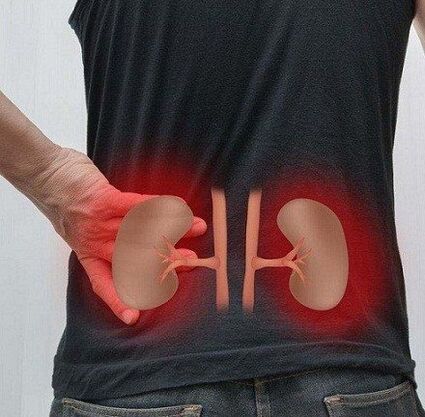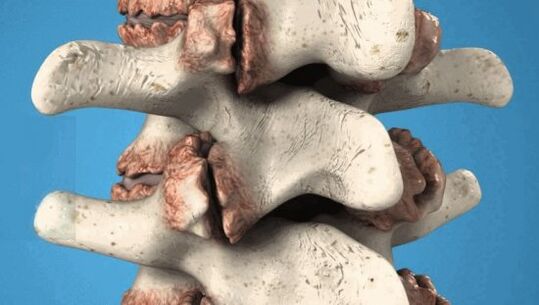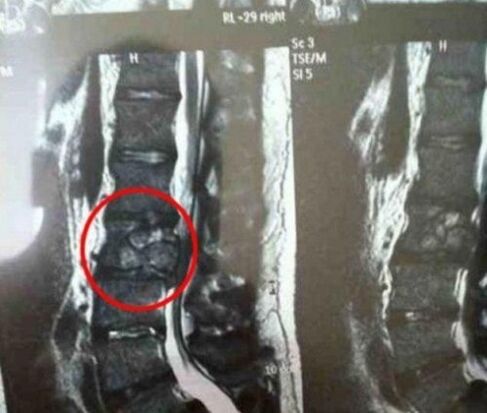
There is virtually no person who at least once in his life would have no back pain in the lower back.With this, we pay for revolt and our home habits.
In addition to damage that can affect the spine, its muscles, nerves and ligaments, it should be borne in mind that sometimes the back in the lower support area hurts with internal diseases - kidney disease, gastrointestinal tract and female genitals.
Symptoms of pain in the lower back may vary from stupid to clear.Pain can occur independently or chronic (the symptom is present for more than three months).
Dangerous!
Take a doctor immediately if:
- Lumbar pain emerged sharply after an obvious back injury;
- The temperature increased markedly, there are autonomic disorders, loss of consciousness, sweating, difficulty breathing;
- The involuntary emptying of the intestine and bladder occurs;
- Numbness is felt in the groin;
- There was a weakness of the lower extremities, its paresis or paralysis, impaired sensitivity;
- The pain is given to the stomach and intensified strongly with cough or sneezing;
- Symptoms appeared against the accentuated weight loss background, long -term steroid use, immunodeficiency;
- In family history, there were cases of cancer, inflammatory or degenerative diseases of bone cherry tissue.
Why do the back hurt in the lower back?
Myofascial pain
Stretching or muscle spasm can gradually develop or happen suddenly.With a high load, damage is affected not only by muscle fibers, but also by a ligament apparatus and fascia.
The muscle pain of the coating appear after:
- raise heavy weights or excessive load during work or sports;
- Sports from time to time.The muscles are especially vulnerable if you are inactive during the work week and then spend the clock at the gym over the weekend;
- An increase in the weight of your own body, behind which the muscles do not have time to grow;
- Long sitting or standing in an uncomfortable position;
- Daily use of a bag on one hand or over the shoulder;
- Moster disorders.The column practices your support and protection function better when you don't include.The muscles in the lumbar region experience the smallest load when you sit with a good support in the lower back and, in position, is evenly distributing the weight to both legs.
If the back are sick after a bruise, a fracture, stretching, hypothermia, an infectious disease, or the installed helm tinty invasion, the myositis (inflammation) of the lumbar muscles may be suspected.Intense pain is constantly present due to inflammation of muscle fibers, the "nodules" are felt in the spasm of the muscles.Inflammation can be acute or take a chronic form.With a long course of the disease, pain is unstable, intensifies with prolonged lying or sitting, closer to night or to change the climate.Touching the muscles causes a sense of pain and discomfort, the lumbar muscles are in constant tension, inflammatory forms of edema, the temperature increases locally and at the level of the whole body.
In the case of muscle spasm, the roots of the spinal nerves are violated, so that attacks usually resemble an image of Ishias or radiculitis - burning severe pain in the back of the thigh and leg are observed, the limbs are numb and lose sensitivity.A pronounced muscle tone for myositis causes the patient to occupy a forced position, he walks and lying twisting, moves in semi -fins.
How to treat the muscle pain of the spine?To eliminate inflammation and pain, non -inflammatory drugs and non -esteroid analgesics are used.Medicines can be taken in the form of tablets, ointments, injections, transdermal plaster with a gradual release of active substances.Annoying and hot ointments are also used, which reflectively increase blood flow to the muscles of the lower back.A larger volume of fluid blood helps lixivize inflammation and tissue decay.
Corticosteroid injections and vosotonizing medicines contribute to a decrease in inflammatory edema.
If the cause of the myiotest is an infection or poisoning of the body with toxins of worms, the therapy is initially performed with antibiotics or anti -helmintical agents.In this case, it is impossible to use ointments or heating compression.
Cordillera diseases involving nerve endings
In the lumbar section, the vertebrae are separated by cartilaginous elastic discs that protect the crest of lesions but are subject to wear and aging.
Normally, the disc is a pulpic jelly core surrounded by a denser layer of a fibrous ring.The elasticity of the nucleus is due to its ability to turn on and maintain water: when the load increases, it accumulates water and elasticity increases, when the pressure is reduced, the nucleus gives water and becomes more flat.
Osteochondrosis in the vertebral column department develops in case of violation of food discs (their "drying") or with excessive local load.Most of the time, back pain are due to the fact that the lower poles of their intervertebral discs carry the highest load during the seat by lifting the weights in front of themselves.At the same time, tears, displacements are formed on the discs, vertebral ligaments are damaged, constant painful pain and pulse occurs.
Column pain has several development mechanisms:
- Violation of microcirculation in tissues around the spine and, in particular, in the cephalorean channel, the formation of congestion and edema.Such conditions develop against the background of hypothermia, overheating and inflammatory processes.
- Degenerative processes in spine fixation ligaments.An increase in vertebrae mobility leads to their easy displacement rather than physiological compression, which causes violation of nerves, blood vessels and hernias formation.
- The axial compression of the vertebrae when lifting weights or their damage with excessive rotation (rotation).
- Aseptic inflammation.The destruction of the nucleus leads to exit in the cephalorean channel of sensitizing factors.Irritation of nerve endings occurs, which causes a spasm of muscles that violate neighboring vertebrae - higher and below hernia.Gradually, the reaction covers the entire lower back and leads to the fact that any movements causes a sense of pain.
The weakened disc can be torn with the formation of protrusion, protrusion or prolapse of the core and, as a result - a hernia.The appearance of a hernia exerts pressure on the spinal cord and roots of the spinal nerves.Under such conditions, pulsating lower back pain appears abruptly, which diverges along the violated nerve.The most famous cases of sciatic nerve compression (Ishias) manifest acute pain on the posterior surface of the thigh and leg, dormancy of the hernia side, muscle weakness, involuntary legs unfolding.
Lumbar spine pain intensifies in a sitting and standing position with curves, inclinations.Often, there is a protective muscle reaction - a painful contraction of the muscles (rollers) on both sides of the spine, which isolates the department of overeating.Osteochondrosis subsequently leads to the appearance of lumbosacra radiculitis (inflammation of spinal nerve roots).
Column syndrome is dangerous with violation of the nerves of the lumbar region responsible for innervation of the internal organs (horse tail roots).At the same time, pain is given to the stomach, bladder and intestine function is impaired, power problems arise in men and gynecological diseases in women.
Many patients, due to the fact that the lumbar region hurts a lot, take poses analgesic-rejecting the body to the left, if the right side hurts;Lying on the right side if the hernia is on the left.The appearance of intense pain when pressed in a hernia in the intervertebral interval (call symptom) is also characteristic.
Than treating if the back hurts with osteochondrosis:
- During the pain attack, you can make a anesthetic pose - lie on your back and place the roll under your knees.It is also recommended to sleep on a hard surface;
- From analgesic medications, you can take NSAIDs in or in the form of injections on both sides of the spine at the Lumbar Hotel;
- Use local growth agents such as distracted therapy - mustard plaster, iodine mesh, peppers and ointments;
- Eliminate mytical spasm through manual therapy, acupuncture, vacuum massage, reflexology, gymnastics;
- By broken the acute period, you can use mud treatment, ozockeita, heating.
The treatment of pain with root syndrome includes:
- Ensure the bed regime, lumbar (dry or underwater) traction;
- the use of analgesic block at the site of violation, reception of NSAIDs or weak opioids;
- Physiotherapy - stimulation of microcurrent, electrophoresis with painkillers.
Indications for the operation are constant acute pain, as well as a violation of the function of the internal organs, the development of limb paralysis, the sequestration of a hernia in the spinal canal.
Degenerative-inflammatory lesions
Spondylartros (inflammation of the arched joints of the vertebrae) occurs during degeneration, a decrease in the height and volume of the intervertebral discs.Lumbar pain appears from capsule overload and increase pressure on the surface of the intervertebral joints.The pain causes the patient to lean more into the lower back, thus increasing the overload of the intervertebral joints.Particularly discomfort in the lower back is improved wearing heels, long walking, lowering the slopes, the position when the body comes back, for example, when considering something above the head.
In patients with this morning diagnosis, stiffness in the lower back is observed, the pain increases during the day or after load.It has a spilled character and is difficult to clearly show the boundaries: discomfort is determined in glute muscles, inguinal region, lower abdomen, the scrotum in men.This spondylartrosis differs from root syndrome when you can indicate a source of pain points.
What to do to relieve pain?Generally, the adoption of the back in the back helps, bending the legs in the hip and knee joints.
Of drugs, preference is given to non -steroidal and non -non -narcotic analgesics anti -inflammatory drugs.With acute back pain, an intramuscular introduction of NSAIDs gives an intramuscular effect.

The museums are also added as they relieve muscle tension and improve the mobility of the spine.
Psychotherapy has a positive effect as chronic pain introduces the patient into a state of depression.
Spondylosis, unlike osteochondrosis, affects the fibrous ring of the intervertebral disc and the front longitudinal ligaments.With this disease, composite structures are used with formation along the edge of growth vertebrae - osteophytes.These formations cause a violation of microcirculation near the roots of the nerves and lead to the fact that the back in the lower back hurts and the mobility of this department is limited.
Treatment is usually conservative using anti -inflammatory drugs, painkillers, vitamins.A good effect provides electrophoresis, manual therapy, physical therapy (amplipult, laser installation, shock wave therapy to destroy compacted elements and increase spine mobility).
Pay attention!
At an advanced stage, osteophytes are not absorbed.Although its dimensions are small, treatment aims to eliminate inflammation, pain, improving metabolism.If the back doesn't hurt much, nothing is done with the growth.If osteophytes cause constant pain or have large sizes, they may be removed during operation.
Tumor Nature Diseases

Low pain can occur from the compression of the spinal cord with a tumor outside (extramedular formations) and inside (intramedullar, originating from the spinal substance itself).
Cells of various tissues can grow pathologically:
- Fat - Lipoma is formed;
- Nervous roots - neurioma;
- Spinal cord vessels - hemangioma;
- Auxiliary Fabric - Glyimal;
- Bone tissue - osteosarcoma;
- Cartilage Fabric - Condrosarcoma.
The especially malignant tumor process is characterized by pain, which resembles radiculitis (may have a nature on one side and bilateral), a general deterioration in the patient's condition, exhaustion.
If the pathology affects the lumbar vertebrae I -IV, the burnt pain is felt at the front and on the sides of the upper thigh, incomplete paralysis of this area.
In case of damage in the area of lumbar segments IV, the numbness of the paragenic region, the impaired engine and the sensitive innervation of the glute muscles, the back of the thigh, the calf and the incontinence of feces and urine are observed.
A violation pronounced in the work of the pelvic organs occurs during neoplasia in the area of Sacral vertebrae V - III.The patient suffers from sexual impotence or violation of menstruation, constipation or incontinence of feces and urine.
Tumors treatment is specific, painkillers and antitumor medications are prescribed.
As you can see, lower back pain is usually caused by musculoskeletal pathologies.They can be diagnosed with clinical signs and study data, whose main task is to correctly determine the nature of the disease and not confuse it with cancer, diseases of internal organs or injuries.If lumbar pain appears, we always recommend that you seek a neuropathologist or orthopedist for counseling.

























